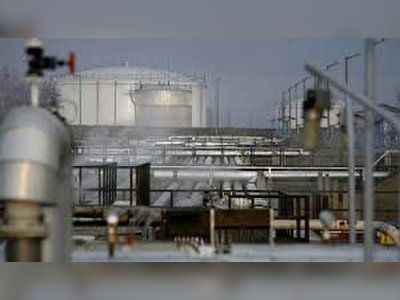Significant Rise in Housing Prices Linked to New Industrial Developments in Hungary
Real estate market analysis reveals substantial price increases in Hungarian cities experiencing new factory establishments.
In 2024, the Hungarian residential property market is expected to see nearly a one-third increase in transactions, accompanied by a nominal price rise of 13.8%, according to a recent analysis by OTP, based on preliminary real estate transaction data from the Tax Authority (NAV).
This translates to a nearly double-digit increase in real terms.
The overall value increase for Budapest and smaller cities was reported at 8%, with 9% in county capitals and a notable 19% in rural municipalities.
Among the counties, Bács-Kiskun exhibited the highest price rise at 20%, whereas the lowest increases were recorded in Zala and Jász-Nagykun-Szolnok at 3%.
Kecskemét, a major city, saw a significant upturn of 15.3% as new industrial capacities are being established, including expansions by Mercedes and Nissin.
The current housing situation in Kecskemét is under scrutiny as the rapid industrial growth outpaces the development of housing options, compounded by issues related to funding plans for a new urban quarter linked to a university foundation's controversial loans.
Following Kecskemét, cities such as Szeged, Debrecen, and Salgótarján recorded increases in the range of 13-14%, attributed to the establishment of large-scale, labor-intensive manufacturing capacities in these locations, such as CATL and BYD.
In Budapest, the XXIII District has seen the highest price changes, with a 19% increase, followed closely by districts X, XI, IV, and VI, which also exceeded 15% growth.
The average price per square meter in Budapest surpassed 1 million HUF, reaching 1,029,000 HUF/m² last year.
Debrecen led the county seat price ranking last year, marking a substantial advantage over Győr, Szeged, Veszprém, and Székesfehérvár, with average prices ranging from 690,000 to 715,000 HUF/m².
Conversely, Salgótarján remained at the bottom of the ranking with an average price of 226,000 HUF/m², now crossing the 200,000 HUF threshold for the first time.
The real estate market dynamics saw significant activity last year, with transactions in Budapest increasing by 47%, and the total number of transactions expected to approach 35,000.
However, this figure still pales in comparison to some counties, where transaction numbers soared by 86% in both Pest and Baranya counties.
Kaposvár reported the most substantial increase among cities, with a 70% rise in property transactions compared to 2023.
When assessed in a European context, Hungary's residential market ranks highly in transaction volume and price dynamics, although it lags markedly in terms of new housing construction.
Recent government initiatives, including a 300 billion HUF funding support for construction by asset managers, aim to address this disparity.
However, expectations for a return to previous long-term market growth in transaction volume or price dynamics remain subdued due to ongoing geopolitical and economic uncertainties, coupled with increasing concerns regarding housing price overvaluation against a theoretical equilibrium.
An analysis indicates that average citizens are facing heightened challenges in affording their own homes, which does not suggest a trend towards intensified market activity.
Furthermore, a recent statement from Ingatlan.com highlighted a slowdown in price escalation, with the rate for Budapest declining to 1.2% on a monthly basis by May 2025, although the annual rate still surpassed 19%.
Outside of the capital, the momentum appears to be shifting toward emerging regions.
The summer season may see little change in the Budapest sales market due to seasonal effects and the current elevated price levels, while towns with lower housing prices may experience a more active market.
According to experts, this market slowdown could present advantages for buyers, improving negotiating positions and potentially leading housing prices toward greater affordability.
This translates to a nearly double-digit increase in real terms.
The overall value increase for Budapest and smaller cities was reported at 8%, with 9% in county capitals and a notable 19% in rural municipalities.
Among the counties, Bács-Kiskun exhibited the highest price rise at 20%, whereas the lowest increases were recorded in Zala and Jász-Nagykun-Szolnok at 3%.
Kecskemét, a major city, saw a significant upturn of 15.3% as new industrial capacities are being established, including expansions by Mercedes and Nissin.
The current housing situation in Kecskemét is under scrutiny as the rapid industrial growth outpaces the development of housing options, compounded by issues related to funding plans for a new urban quarter linked to a university foundation's controversial loans.
Following Kecskemét, cities such as Szeged, Debrecen, and Salgótarján recorded increases in the range of 13-14%, attributed to the establishment of large-scale, labor-intensive manufacturing capacities in these locations, such as CATL and BYD.
In Budapest, the XXIII District has seen the highest price changes, with a 19% increase, followed closely by districts X, XI, IV, and VI, which also exceeded 15% growth.
The average price per square meter in Budapest surpassed 1 million HUF, reaching 1,029,000 HUF/m² last year.
Debrecen led the county seat price ranking last year, marking a substantial advantage over Győr, Szeged, Veszprém, and Székesfehérvár, with average prices ranging from 690,000 to 715,000 HUF/m².
Conversely, Salgótarján remained at the bottom of the ranking with an average price of 226,000 HUF/m², now crossing the 200,000 HUF threshold for the first time.
The real estate market dynamics saw significant activity last year, with transactions in Budapest increasing by 47%, and the total number of transactions expected to approach 35,000.
However, this figure still pales in comparison to some counties, where transaction numbers soared by 86% in both Pest and Baranya counties.
Kaposvár reported the most substantial increase among cities, with a 70% rise in property transactions compared to 2023.
When assessed in a European context, Hungary's residential market ranks highly in transaction volume and price dynamics, although it lags markedly in terms of new housing construction.
Recent government initiatives, including a 300 billion HUF funding support for construction by asset managers, aim to address this disparity.
However, expectations for a return to previous long-term market growth in transaction volume or price dynamics remain subdued due to ongoing geopolitical and economic uncertainties, coupled with increasing concerns regarding housing price overvaluation against a theoretical equilibrium.
An analysis indicates that average citizens are facing heightened challenges in affording their own homes, which does not suggest a trend towards intensified market activity.
Furthermore, a recent statement from Ingatlan.com highlighted a slowdown in price escalation, with the rate for Budapest declining to 1.2% on a monthly basis by May 2025, although the annual rate still surpassed 19%.
Outside of the capital, the momentum appears to be shifting toward emerging regions.
The summer season may see little change in the Budapest sales market due to seasonal effects and the current elevated price levels, while towns with lower housing prices may experience a more active market.
According to experts, this market slowdown could present advantages for buyers, improving negotiating positions and potentially leading housing prices toward greater affordability.
AI Disclaimer: An advanced artificial intelligence (AI) system generated the content of this page on its own. This innovative technology conducts extensive research from a variety of reliable sources, performs rigorous fact-checking and verification, cleans up and balances biased or manipulated content, and presents a minimal factual summary that is just enough yet essential for you to function as an informed and educated citizen. Please keep in mind, however, that this system is an evolving technology, and as a result, the article may contain accidental inaccuracies or errors. We urge you to help us improve our site by reporting any inaccuracies you find using the "Contact Us" link at the bottom of this page. Your helpful feedback helps us improve our system and deliver more precise content. When you find an article of interest here, please look for the full and extensive coverage of this topic in traditional news sources, as they are written by professional journalists that we try to support, not replace. We appreciate your understanding and assistance.











